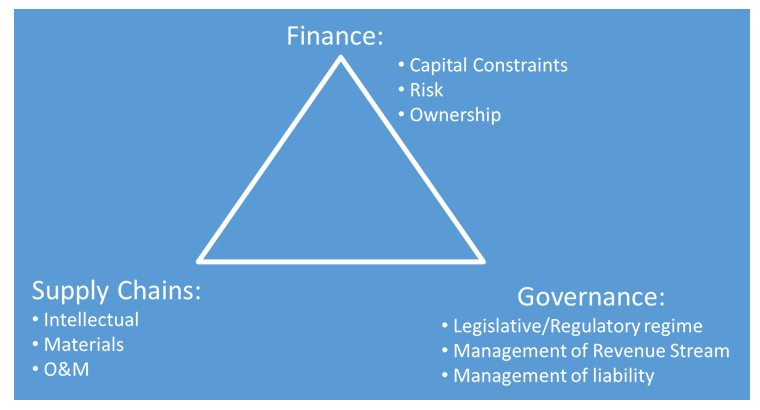What's stopping solar's assault on diesel?
Remote and regional areas of Australia have some of the highest marginal costs of generation anywhere in Australia yet are located in areas with some of the highest renewable energy resource potential – in particular solar.
With high energy costs being a key barrier to further development of much of northern/remote Australia, alternatives to the existing modes of generation, transmission and consumption of electrical energy must be considered – if only to act as a hedge to fluctuations in energy prices.
Indeed, it is not simply the existing high costs of energy in remote Australia that are cause for concern, it is also the fact that so much of regional and remote Australia rely on imported liquid fuels, principally diesel or bunker oil. This is a commodity for which regional and remote Australia will likely to be a price “taker” rather than a price “maker” in the energy marketplace. With most imports coming from Singapore, regional and remote Australia are doubly exposed to both oil price fluctuations and variation in foreign exchange rates.
With PV prices being driven lower and lower, and diesel prices climbing, there would appear to be a prime facie case for renewable deployment in these remote areas. Indeed, with the marginal cost of generation from diesel power systems hovering around $250-$400/MWh and PV systems being able to be installed for an effective cost of between $200-$240/MWh (low penetration and excluding storage), it must be assumed that there are some other, non-cost related underlying structural barriers that are preventing or delaying the deployment of renewables.
Extensive research undertaken by CAT Projects throughout Australia and internationally has identified a common set of structural barriers to deployment of renewables in remote areas. These have been generally classified as:
Governance – The regulatory or legislative framework creates a series of split incentives for the operation of individual power systems, resulting in benefits of a renewable power system not being efficiently attributed to the bearer of the costs of deployment
Supply chains – The general presumption with remote area power system is that the supply chain barrier is either purely technical “we need better widgets” or purely economic “the widgets need to be cheaper”. In practice, however, the supply chain constraints are more significantly evident in:
i) Intellectual supply chain – There is insufficient capability or capacity within the key decisions makers to facilitate the implementation of renewables – i.e. the power system engineers charged with designing a power system, may not have any experience of modern renewables and therefore default to a more conservative approach;
ii) Labour supply chain – In many areas there are insufficient electricians, labourers, etc, whom have familiarity with the technologies to ensure the efficient implementation of the renewable power systems, or to operate and maintain those systems into the future;
iii) Logisitical supply chain – existing logistic supply chains have been optimised and refined to support existing technologies. For example, building a multi MW PV system in a remote area may necessitate the transport of many thousands of glass panels along hundreds of kilometres of corrugated dirt roads – the existing transport contractors familiar with the remote area may not be equipped to support the specific requirements associated with remote renewable projects.
Finance – It is generally assumed that the principal financial barrier is one of capital cost, evidence to date, however, suggests that even where the underlying economics of a proposal meet or exceed industry benchmarks for viability, the projects are often unable to proceed due to inability to access finance. This is often driven by one of more of the following:
i) Capital constraints – Although the IRR of a particular project may be consistent with general industry expectations, competition for capital within a particular proponent e.g. a mining company, may be such that an that would be otherwise considered acceptable is not sufficient to pass the threshold requirement for support;
ii) Valuation of risk – Where external financiers are willing to own/finance a project under a PPA (or similar) framework, the return required will be defined by their valuation of the risk of the proposal – this often creates the perverse situation where the entity best placed to understand and value the risk is not the entity having to price the risk within the finance package.
The relationship between these barriers is illustrated below:

The barriers noted above are not exhaustive, and additional barriers could be identified and classified within the broad categories noted above. Notwithstanding this, however, the general principles articulated in framing the barriers in this way stand: namely that what is often assumed to be an issue of technology is actually a series of underlying capacity gaps in differing areas of the overall value chain.
What is interesting is that these barriers are not even explicitly associated with renewables. When we look at a whole range of infrastructure projects across regional and remote areas of Australia and South Asia, we see the same trends coming up over and over again. One solution to the barriers is money: if you throw enough money at the issue, it will eventually get resolved ... or you will go broke trying. In fact, this is largely how mining companies have dealt with these issues for many of their large remote projects. And that is fine when revenue is high; however when money is tight a little bit more innovation is required.
In the next few articles I will discuss some of the specific barriers and opportunities that exist for renewables in remote and regional areas, and what some of the more effective responses are.
Lyndon Frearson is general manager of CAT Projects, a company which specialises in remote area project management, energy and power system engineering.
The company has been assisting a network of Indian community organisations and RE industry participants, as well as the Government of India, to establish a widely replicable model for the electrification of remote villages using centralised solar PV energy systems.
















